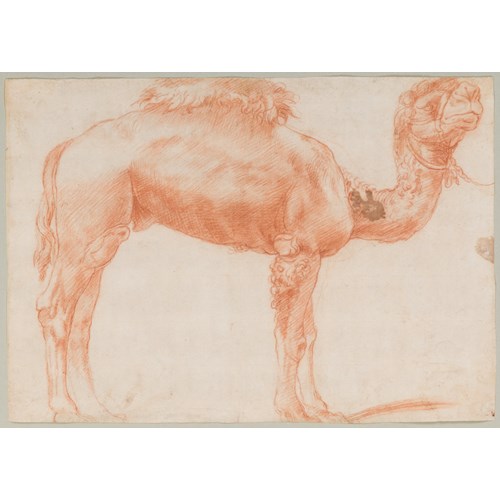Marketplace
A Eurasian Black Vulture
Willem VAN DEN BERG
A Eurasian Black Vulture
Date 1922
Period 20th century
Origin Dutch
Medium Oil on panel.
In the 1920s and 1930s Willem van den Berg often found inspiration in the central Amsterdam Royal Zoo Artis (or Natura Artis Magistra); the oldest zoo in the Netherlands, founded in 1838, and indeed one of the oldest in Europe - where he sketched studies of animals and birds which would later be worked up in the studio as more finished drawings or paintings, as well as lithographs and woodcuts. Several of van den Berg’s drawings of animals are today in the collection of the Rijksakademie van Beeldende Kunsten in Amsterdam.
This small painting depicts a cinerous vulture (Aegyptius monachus), also known as a Eurasian black vulture or monk vulture. A type of so-called Old World vulture with black plumage and a bald head with a ruff of neck feathers (hence the name ‘monk vulture’), the cinerous vulture is a large raptor with a range extending across much of Europe and Asia. It is, however, extinct in much of the western half of its range, and endangered elsewhere. There are an estimated 4,500 cinerous vultures which survive today.
Willem van den Berg made several drawings and paintings of exotic birds which he saw at the Amsterdam Zoo. That unusual creatures such as this vulture captured his imagination is evident in the several studies he produced of these impressive birds of prey. A pen, ink and brown wash drawing of a vulture is in the Teylers Museum in Haarlem, while a similar, very large pastel study of a resting vulture appeared at auction in Amsterdam in 2003. The present sheet is also closely related to a woodcut of a vulture in profile by van den Berg.
This small painting once belonged to the eminent Dutch art historian and museum director H. E. van Gelder (1876-1960), who served as director of the Gemeentemuseum in The Hague between 1912 and 1941.
This small painting depicts a cinerous vulture (Aegyptius monachus), also known as a Eurasian black vulture or monk vulture. A type of so-called Old World vulture with black plumage and a bald head with a ruff of neck feathers (hence the name ‘monk vulture’), the cinerous vulture is a large raptor with a range extending across much of Europe and Asia. It is, however, extinct in much of the western half of its range, and endangered elsewhere. There are an estimated 4,500 cinerous vultures which survive today.
Willem van den Berg made several drawings and paintings of exotic birds which he saw at the Amsterdam Zoo. That unusual creatures such as this vulture captured his imagination is evident in the several studies he produced of these impressive birds of prey. A pen, ink and brown wash drawing of a vulture is in the Teylers Museum in Haarlem, while a similar, very large pastel study of a resting vulture appeared at auction in Amsterdam in 2003. The present sheet is also closely related to a woodcut of a vulture in profile by van den Berg.
This small painting once belonged to the eminent Dutch art historian and museum director H. E. van Gelder (1876-1960), who served as director of the Gemeentemuseum in The Hague between 1912 and 1941.
Date: 1922
Period: 20th century
Origin: Dutch
Medium: Oil on panel.
Signature: Signed WvdBERG scratched into the paint surface at the lower centre.
Further signed and dated W. van den Berg / 1922 on the reverse of the panel.
Provenance: Hendrik Enno van Gelder and Johanna Helena Scalonge, The Hague
Thence by descent
Private collection, The Netherlands.
More artworks from the Gallery







-DELLE SITE-Aeropittura (Aeropainting)_T638114469827299431.jpg?width=500&height=500&mode=pad&scale=both&qlt=90&format=jpg)

